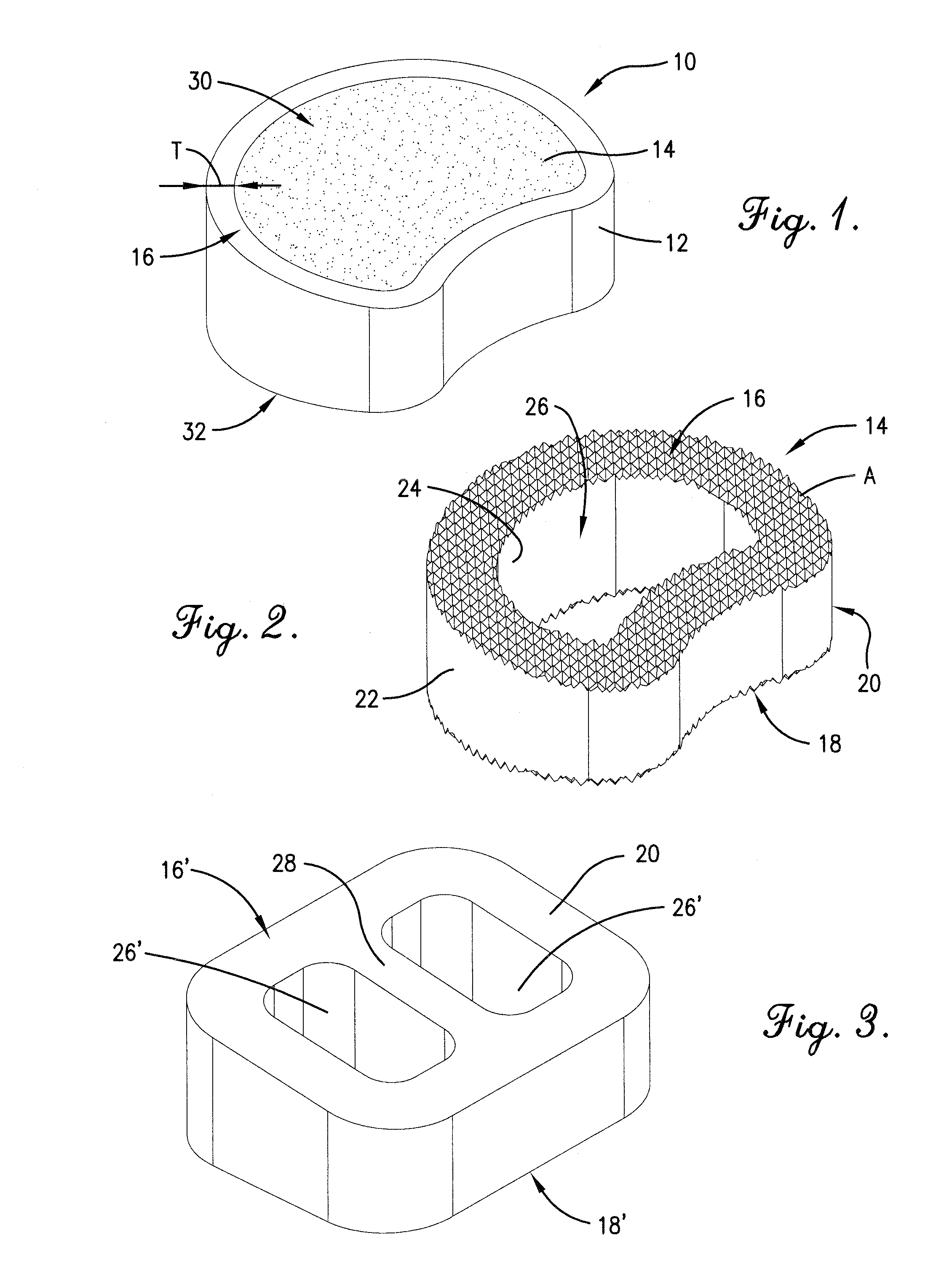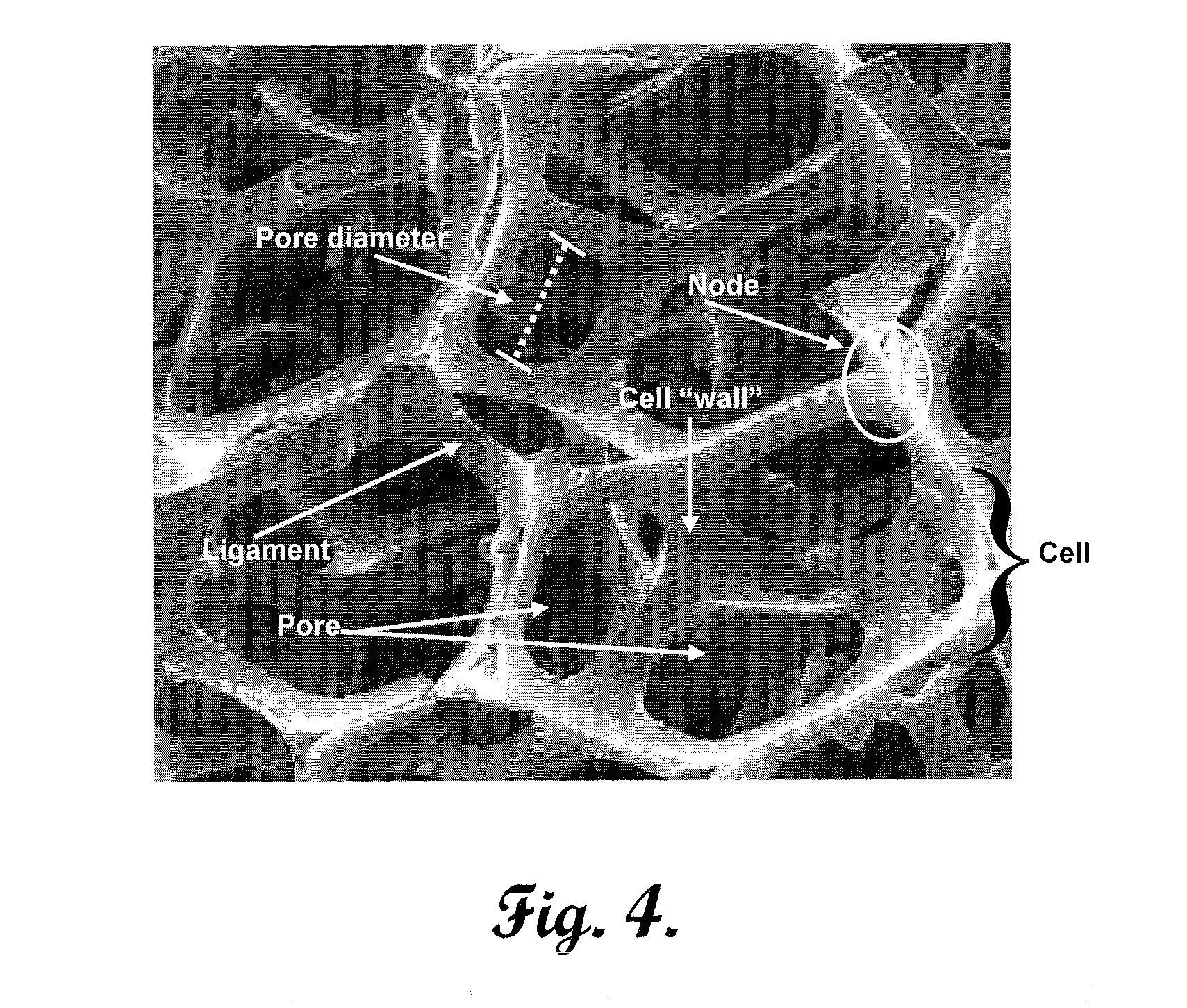Reinforced carbon fiber/carbon foam intervertebral spine fusion device
- Summary
- Abstract
- Description
- Claims
- Application Information
AI Technical Summary
Problems solved by technology
Method used
Image
Examples
example 1
Osteoinductive Properties of Vitreous Carbon Foam Materials
1. Materials and Methods
[0072]In this Example, 6×5 mm carbon foam discs (DUOCEL®, ERG Aerospace) prepared from bulk materials were sterilized in 70% ethanol and exhaustively rinsed in phosphate buffered saline (PBS). For BMP-2 loading studies, foam discs were submerged in PBS containing specified amounts of cytokine for 24 hours. Unbound cytokine was separated from the foam-bound fraction by low-speed centrifugation, followed by 3 rinses in PBS. The BMP-2 that was not adsorbed by the carbon foam was measured in the residual soak and subsequent wash solutions using a sandwich ELISA assay.
[0073]The rinsed discs containing adsorbed BMP-2 were then placed into wells of a tissue culture plate and C2C12 mouse myoblast cells were added to the carbon matrix by direct pipeting. Carbon materials pre-incubated in PBS containing 50, 100 or 200 ng / ml BMP-2 comprised the experimental study groups. Cell culture medium was added to the plat...
example 2
Biomaterial Analysis for Mechanical Properties
[0079]Mechanical testing of a carbon foam material DUOCEL® with a pore size of about 120 μm was performed with strict adherence to the ASTM Standard Test Method for Compressive Properties of Rigid Plastics (ASTM D-695-02a). The material was machined into cylindrical-shaped specimens with a diameter of 1 cm and thickness of 2 cm. The specimens were then tested for mechanical properties using an MTS 858 Bionix material testing system (MTS Model 858, Eden Prairie, Minn.). Load and deflection data were measured and collected by the MTS system every 0.1 seconds. Each specimen was tested in compression loading from ON to complete structural failure at a loading rate of 1.3 mm / min. The maximum stress was then determined, and the results are shown in the table below.
TABLE 1Mechanical Properties of Carbon FoamUltimateUltimateUltimateUltimateLoadStressDisplacementStrain(N)(MPa)(mm)(MPa)Average169312.570.940.026SD2401.750.410.006Max201314.911.990.0...
example 3
In Vitro Biocompatibility of Carbon Foam
1. Initial Testing
[0081]Initial biocompatibility of carbon foam was conducted using a cell culture system developed in our laboratory for the evaluation of patient hypersensitivity to orthopaedic biomaterials. Carbon in both powdered and milled fiber forms was evaluated using mononuclear cells (MNCs) obtained from 40 osteoarthritic patients under investigation for biomaterial sensitivity, along with other conventional biomaterials (polymethylmethacrylate (PMMA), Ti alloy, ultra-high-molecular-weight polyethylene (UHMWPE)). Peripheral blood was obtained from patients and MNCs were separated using Histopaque gradients. Cell suspensions of 2.5×106 cells were dispensed into wells containing various concentrations of biomaterial particles. Wells with no particles (negative control) or with Concanavalin A (ConA) (positive control) were also included on the plate. Plates were incubated for 6 days. Next, 20 μl of MTT solution (5 mg / ml) were then to ea...
PUM
 Login to View More
Login to View More Abstract
Description
Claims
Application Information
 Login to View More
Login to View More - R&D
- Intellectual Property
- Life Sciences
- Materials
- Tech Scout
- Unparalleled Data Quality
- Higher Quality Content
- 60% Fewer Hallucinations
Browse by: Latest US Patents, China's latest patents, Technical Efficacy Thesaurus, Application Domain, Technology Topic, Popular Technical Reports.
© 2025 PatSnap. All rights reserved.Legal|Privacy policy|Modern Slavery Act Transparency Statement|Sitemap|About US| Contact US: help@patsnap.com



